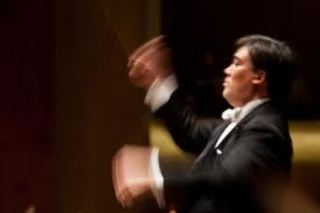|
Back
An “A” For The Alternative “Three B’s” New York
Avery Fisher Hall, Lincoln Center
10/23/2014 - & October 24, 25, 28, 2014
Béla Bartók: Piano Concerto No. 3, BB 127
Anton Bruckner: Symphony No. 8 in C Minor (Nowak edition)
Yefim Bronfman (Piano)
New York Philharmonic Orchestra, Alan Gilbert (Music Director/Conductor)

Y. Bronfman (© Dario Acosta)
The three B’s of this week’s Philharmonic concert were not your usuals. Last night, they were Bartók, Bruckner, and Bronfman. And the “A” in the title was first, for Alan (conductor Alan Gilbert). And second, an “A” rating for an out-of-the-ordinary reading of Bruckner’s long C Minor Symphony, and a very special reading of Béla Bartók’s Third Piano Concerto.
That Concerto, by the way, makes us all feel embarrassed. Although written while the composer was dying, Bartók gave this felicitous jewel as a birthday present to his wife. Compared to the cheap coffee-grinders, scarves and steak dinners we give our own partners on their birthdays, Bartók makes us feel...well, insignificant, to say the least.
Last night, Yefim Bronfman showed exactly why he is Yefim Bronfman. That muscularity, the easy-going perfection, that pent-up strength which is wisely rationed... This is what we expect from the Israeli-American artist.
But more than this is the thoughtfulness in every note he plays. The opening seemed to encompass what the whole Concerto was about. It was soft and firm, the gracefulness was like an architectural foundation, ready for lines to blossom. Not once in this beginning did he falter, did he feel that homage must be given to the dying artist. This was an acuity without a hint of affectation.
Yet it was the second movement, Adagio religioso, where Mr. Bronfman and Mr. Gilbert together performed a kind of avian apotheosis. Alan Gilbert brought the bird songs from the woodwinds, not as chirps, but stylized songs, with Mr. Bronfman playing his lines again with that sense of thought, even meditation.
To those aware of Bartók’s medical condition, the finale is almost impossible. This was not the ironic joke of a dying Mahler, but the unleashed coltishness of a callow youth. Mr. Bronfman could have galloped through it, but he didn’t. For behind the playfulness was a slight prescience of more important things to come. In this case, a simple chorale, not liturgical, but the chorale of a composer who began life taking down simple tunes, and finishing with tunes that had breadth, meaning, and under Bronfman’s hands, an intrinsic glory.
It was a strange pairing to bring Bruckner’s Eighth after the intermission. Bartók offered a message of earthly felicity. Bruckner proposed bringing heaven down to earth. The Bartók seemed far far shorter than its 23 minutes. Bruckner can be (and often is) far longer than its 80-odd minutes.

A. Gilbert (© New York Philharmonic)
Mr. Gilbert, though, was not ready to stretch our the Bruckner to heavenly length. He knew that Bruckner’s score calls for literal leeway, that the composer insisted on bringing angels, prayers, supplications and Divine Majesty in his own singular way. So by taking the first and last movements at a cool controlled pace, Mr. Gilbert began that great architectural opening with a kinetic tempo, and retaining that tempo as much as possible.
He also had a Phil which offered a unique color this week. The strings, in fact, came near that “saturated” color which one heard ten days ago in the Berlin Philharmonic concerts. Besides this, the virtuoso displays of oboe, clarinet, and most of all, the First Horn solos by the great Philip Myers, both in the clarions and the softest passages, were most sensitive.
I have seen audiences fidget through several Eighth performances. But except for a pair of women who strolled out in the middle, Mr. Gilbert was able to hold the audience, if not spellbound then at least with interest. And in the third movement, built on the slightest downward scale and building up to the highest pantheon, Mr. Gilbert’s strings were firm, were singing and gave aural proof of Bruckner’s vision.
The finale, like all Bruckner’s finales, leave me puzzled. Yes, he piles chord upon chord, brass upon brass, getting higher and higher and more magnificent. Mr. Gilbert, obviously so committed to Bruckner, retained the building of the tower.
But then, suddenly it’s over. Perhaps in the mid-19th Century, heaven had a beginning and an end. We in the ever-expanding universe, hate to see it come to an end, even with those soaring C Major chords. (Mahler’s Ninth had the decency to let it come down softly, as if it was impossible to know how far the mind can go.)
That, though, was hardly Alan Gilbert’s fault. He conducted not only with care, and sensitivity, but he took this Gothic assemblage of themes as a complete triumphal unit.
Harry Rolnick
|